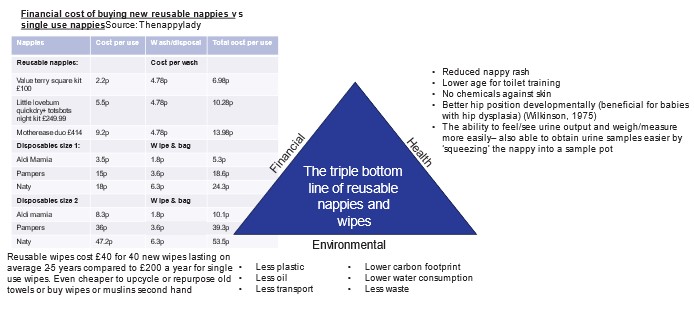Maternity care is the start of life encompassing public health for the mother/birthing person, their growing baby and their immediate support network too.
The impacts of global warming, heatwaves, adverse weather events and air pollution all have impacts for fertility, pregnancy, fetal development and child health.
Midwives and obstetricians can work in collaboration with women to provide education and promote more environmentally sustainable changes during pregnancy and postpartum which helps to reduce the carbon footprint having a baby brings.
Like many parents, having children is the catalyst to motivate interest and action within the sustainability movement. Seeing first-hand what humans consume triggers the thought of ‘will our children be left with a usable planet?’.
My own journal to sustainability began as a student health visitor, I delivered baby weighing clinics in two areas: one which was more affluent than another which had a 50% reusable nappy user rate. I noticed there were fewer instances of nappy rash, no requests for prescription nappy rash creams and the beautiful designs caught my eye.
When I had my eldest, I started with single use nappies due to my limited knowledge. But at 4 days old my daughter’s skin was red raw and peeling from using single use wipes and cotton wool. I quickly converted to reusable wipes which improved her skin but continued to need barrier creams. At 8 weeks old, frustrated by the “poonami” leaks up her back I converted to reusable nappies, which resulted in no longer needing barrier creams and actually ended up with less washing rather than more because reusable nappies were more reliable than single use nappies.
Those simple changes took me on a real sustainability journey: from reusable wipes and menstrual products, exploring more eco refillable cleaning products, second hand clothing and toys, reusable gift wrapping to even solar panels; that one simple change snowballed into other swaps and changes.
It also led me to begin volunteering as both a breastfeeding peer supporter with the children’s centres and a cloth nappy library volunteer for the Wiltshire wildlife trust. I organised meetups and helped many families transition from single use nappies to cloth, sharing my own personal story of success.
I was delighted when there was one month where 13 families transitioned to cloth nappies in the area. The average family converted across between 4-6 months which saved around 4000 nappies per child being manufactured and disposed of.
Supporting parents with the overwhelming choice with reusable nappies, dispelling myths, sharing cost effective ways to buy cloth nappies, providing kits to hire to try the options before buying and troubleshooting any issues or concerns helped many parents move across, which again can act as a catalyst for many other lifestyle changes benefitting the planet and our children.
I then explored trying to influence a bigger audience through social media (@Theecomidwife) trying to help make cloth nappies and wipes more mainstream. The use of social media has its challenges particularly being a healthcare professional and following professional codes of conducts, but it enables messages to reach a much bigger audience with a much wider range of demographics.
It allowed me to promote messages of sustainability to those who perhaps would have followed for maternity or parenting information but witnessed the underlying sustainable messages such as reusable menstrual wear and nappies and more sustainable baby products, helping them consider more sustainable lifestyle choices and parenting swaps.
The triple bottom line is used as an example of driving sustainable change within healthcare meaning that people, planet and prosperity are considered in decision making. It became clear to me that reusable nappies and wipes have a triple bottom line for families too. Reduced costs (particularly important for cost-of-living crisis), health and climate awareness help persuade many parents to make the switch.
This has taught me that sustainability leadership can be as simple as having a conversation with the people in your care and influencing them through education and conversation. If you explain to people, for example, the co-benefits of reusable wipes and nappies, or of dry powder inhalers, or a digital appointment then some of those people may make changes based on one conversation.
They may then talk openly about those changes to other people: furthering change. The cycle continues, snowballing into more changes and gaining more momentum. This was how the cloth nappy library worked so well. The more people who had support or transitioned across to cloth, the more conversations they would then have at baby or parenting groups, prompting change or at least the contemplation of change in many other parents.
Becoming sustainable in my parenting journey sparked me into looking for things I could reduce consumption of in my community midwifery job too. I used to ask women to reuse their urine sample pots in the community which was received positively when the financial and environmental benefits were explained, and in my specialist role I made an action plan to help with the transition electronic fetal monitoring archiving and storage to become paperless.
These small steps and finding my passion and niche in the sustainability world made me apply to become a Chief Sustainability Officer’s Clinical Fellow, which is now my current role. This year I have several projects ongoing to explore the decarbonisation of care pathways particularly in relation to maternity care, women’s health and community care in my region. Thinking about carbon impacts from the outset can make it easier to implement more sustainable models of care from the outset rather than bolting on or having to reconfigure care pathways as an afterthought.
Such actions are important for reducing the health impacts of high emission healthcare and injustices future generations are set to face. Every baby born today will be increasingly impacted by climate change. As both a midwife and a parent, it is this which motivates me act.
All of this has taught me that the world doesn’t need a small number of people being perfect at sustainability: it needs everyone collectively making small imperfect changes and to find our sustainability niche.
What do you care about?
What do you enjoy?
What are you good at?
What might you have influence over?
My sustainability niche is bringing sustainability into parenting and maternity care.
What’s yours?

Five facts on how climate change impacts fertility and pregnancy
- For each 1’C increase during a heatwave, preterm and stillbirth increases. In a heat wave pre term birth 1.16x higher. A 10’C increase led to a 45% chance of stillbirth in a heatwave highest amongst black and Hispanic women
- 15 days of temperatures over 30’c increased ASD (atrial septal defects) especially at 8 weeks gestation
- High temperatures in weeks 21 and 22 increases gestational diabetes chance
- Air pollution increases pre eclampsia, gestational diabetes, cardiovascular disease, miscarriage and pre term birth
- The closer to a main road a woman lives, there is a reduction both in spontaneous conception but also a reduction in IVF treatment leading to successful pregnancy and live birth
Facts on reusable nappies and wipes
- The average baby will use 4500-6000 single use nappies compared to needing 20-25 birth to potty reusable nappies or 30-35 muslins and wraps
- Single use nappies and wipes and menstrual products account for 7,832,000 tonnes of waste in the EU every year
- 51 trillion microplastic particle litter the oceans threatening marine life
- It take 1 cup of crude oil to make one single use nappy
- Manufacturing one week of single use nappies uses 1550litres of water compared to a total of 200litres to wash in 3 wash loads.
- 300,000 sewer blockages are caused by single use wipes every year
- Using reusable nappies from birth to potty (new, not preloved) uses 345kg of C02 emissions from source to washing compared to 457kg with single use nappies. This is lower with pre loved as only the washing accounts for the C02 emissions.
- The average family will use 6000 single use wipes a year costing an average of £200 a year. In comparison 40 single use wipes will cost £40 and last on average 3 years + (Mine are 5 years old now)
- 7million trees a year are cut down to make the pulp for single use nappies in the UK
- Reusables use 97.5% less raw materials over 2.5 years than disposables (128.36kg vs 3.22kg)
- If every child used reusable nappies each year it would be the equivalent of 3000 car journeys to the moon
- If washed and cared for reusable nappies can be used on multiple children – highlighting the benefits for those families who want more children in the future or childcare sectors
References:
DEFRA (2023) Lifecycle analysis of cloth nappies Science Search (defra.gov.uk)
Sustainability in Quality Improvement (SusQI) | Centre for Sustainable Healthcare
The Nappy lady Do Reusable Nappies Really Save You Money? May’23: NappyLady (thenappylady.co.uk)
Author

Angie Willis
Angie is a Registered Midwife and Health visitor with over 11 years experience and she also provides private antenatal and postnatal services to parents. Angie is currently on a years secondment with NHS greener team working in BSW ICB implementing sustainability projects alongside her leadership training. She has a Masters in professional development with special interests in maternal mental health, birth choices & public health. In her free time she is a breastfeeding and cloth nappy volunteer and mum to two girls.
Declaration of interests
I have read and understood the BMJ Group policy on declaration of interests and declare the following interests: : I am in collaboration with The Nappy Lady and have been since 2020 (after being a cloth nappy volunteer for my local library). In this collaboration I get sent reusable products in return for social media posts. My other conflict of interest is my year’s fellowship with is funded by GNHS team.